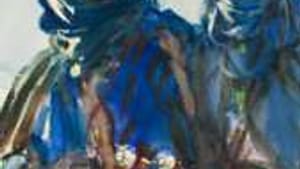Stay in the Loop
BSR publishes on a weekly schedule, with an email newsletter every Wednesday and Thursday morning. There’s no paywall, and subscribing is always free.
Worlds apart from his portraits
Sargent watercolors at Brooklyn Museum

The landmark exhibit of Sargent watercolors at the Brooklyn Museum could carry a warning label: Don't Try This at Home. Sargent's command of what is often considered an entry-level paint medium is so far beyond the merely mortal that amateur attempts are bound to end in disappointment.
Not that the Brooklyn Museum isn't trying to help, with a wall full of technical specs and a demonstration video by an accomplished watercolor artist. But the parsing of technique— pigment choice, size of brush, degree of wetness, direction of stroke"“ only emphasizes the distance between educated practice and inspired creation.
Sargent is an artist claimed by America, but he was American only by nationality. He was born in Italy to ex-pat parents (his father had been an eye surgeon at Willis Eye Hospital in Philadelphia) but developed his skills and his career in Europe and spent virtually his entire life there.
His name is nearly synonymous with the glamorous fashion portrait of the late 19th Century; a likeness by Sargent was a valued prize for the wealthy of Paris and London as well as among sophisticated circles in America. But for all his commercial success, his most famous works— including the "shocking" Madame X and the intriguing Daughters of Edward Darley Boit— attest that he was no obedient artist-for-hire.
Fresh intimacy
His watercolors, in some ways a world apart from his oils (as artists' drawings and works on paper often are), are unmistakably the product of the same confident, bravura hand that painted the famous portraits. To his signature virtuosity, the watercolors add a fresh intimacy that puts the viewer into the personal space where Sargent painted them. His brilliant flurries of strokes and dabs and marks exude an ephemeral magic that breathes a freer air. Many of these works are so alive that they seem barely dry.
Most of the exhibit's 93 paintings are from Sargent's travels, primarily around Europe but also notably into desert areas of North Africa. The Bedouin he found there gave him some of his most arresting images: stark contrasts of light and shade, voluminous robes in deep cobalt blue, flowing layered tents, black-rimmed eyes staring back across a broad cultural divide. These paintings convey a nonchalant glamour but also the closely observed truth of a lifestyle exotic to an outsider but routine to those living it.
One of the most striking works shows a mother holding a small child. She stands in the heat of the desert sun under their tent, her face lost to shadow, her hands and the child's delicate feet thrust forth into the harsh light. Vigorous darks— browns, blues, blacks— swirl around the focal point of bright exposed skin, speaking of protection and vulnerability, fragility and strength.
Boats and beaches
Mundane subjects often inspired Sargent to astonishing results. La Blancheria, a simple scene of wash drying in the sun, is a tour de force of light and shade defined with brisk, decisive color and technique. Boats Drawn Up is another, with a bold composition that slants a white sail clear across the page and fills the space beneath with a complex shaded tangle of boats, beach and napping sailors.
Here, as in many of his works, Sargent's favored cobalt blues and ochres provide the rich basis for infinite variations of tone and shade. This palette is brilliantly effective in his paintings from the marble quarries at Carrara, an astonishing series that comes close to complete abstraction at times.
Portraits from this supreme master of portraiture are here, too. Some of them feature Sargent's friends and family, posed and unposed, usually outdoors at sunny picnics and gatherings. In the best, faces are barely recognizable as such, acting as points of reference to hold the joyous swirling mounds of foliage and frothy dresses in place.
Rembrandt's depth
Sargent also painted his artist companions, but the most extraordinary portrait in the show is titled A Tramp. This noble face with piercing eyes staring out from a ragtag swirl of greys and browns possesses the tossed-off nonchalance of Sargent's best work, but it rivets the viewer with the nuanced psychological depth of a Rembrandt.
The works on exhibit in Brooklyn date from the late 19th Century to just before the start of World War I. Not only are Sargent's paintings rich and beautiful, but they also serve poignantly to document a world that would soon disappear or be forever changed. So these works stand as an important record as well as an aesthetic delight.
The Brooklyn Museum owns many of the works in this show, but they're not often on display. This exhibit, jointly organized with the Museum of Fine Arts in Boston, offers a rare opportunity to see these treasures in lavish quantity.
Not that the Brooklyn Museum isn't trying to help, with a wall full of technical specs and a demonstration video by an accomplished watercolor artist. But the parsing of technique— pigment choice, size of brush, degree of wetness, direction of stroke"“ only emphasizes the distance between educated practice and inspired creation.
Sargent is an artist claimed by America, but he was American only by nationality. He was born in Italy to ex-pat parents (his father had been an eye surgeon at Willis Eye Hospital in Philadelphia) but developed his skills and his career in Europe and spent virtually his entire life there.
His name is nearly synonymous with the glamorous fashion portrait of the late 19th Century; a likeness by Sargent was a valued prize for the wealthy of Paris and London as well as among sophisticated circles in America. But for all his commercial success, his most famous works— including the "shocking" Madame X and the intriguing Daughters of Edward Darley Boit— attest that he was no obedient artist-for-hire.
Fresh intimacy
His watercolors, in some ways a world apart from his oils (as artists' drawings and works on paper often are), are unmistakably the product of the same confident, bravura hand that painted the famous portraits. To his signature virtuosity, the watercolors add a fresh intimacy that puts the viewer into the personal space where Sargent painted them. His brilliant flurries of strokes and dabs and marks exude an ephemeral magic that breathes a freer air. Many of these works are so alive that they seem barely dry.
Most of the exhibit's 93 paintings are from Sargent's travels, primarily around Europe but also notably into desert areas of North Africa. The Bedouin he found there gave him some of his most arresting images: stark contrasts of light and shade, voluminous robes in deep cobalt blue, flowing layered tents, black-rimmed eyes staring back across a broad cultural divide. These paintings convey a nonchalant glamour but also the closely observed truth of a lifestyle exotic to an outsider but routine to those living it.
One of the most striking works shows a mother holding a small child. She stands in the heat of the desert sun under their tent, her face lost to shadow, her hands and the child's delicate feet thrust forth into the harsh light. Vigorous darks— browns, blues, blacks— swirl around the focal point of bright exposed skin, speaking of protection and vulnerability, fragility and strength.
Boats and beaches
Mundane subjects often inspired Sargent to astonishing results. La Blancheria, a simple scene of wash drying in the sun, is a tour de force of light and shade defined with brisk, decisive color and technique. Boats Drawn Up is another, with a bold composition that slants a white sail clear across the page and fills the space beneath with a complex shaded tangle of boats, beach and napping sailors.
Here, as in many of his works, Sargent's favored cobalt blues and ochres provide the rich basis for infinite variations of tone and shade. This palette is brilliantly effective in his paintings from the marble quarries at Carrara, an astonishing series that comes close to complete abstraction at times.
Portraits from this supreme master of portraiture are here, too. Some of them feature Sargent's friends and family, posed and unposed, usually outdoors at sunny picnics and gatherings. In the best, faces are barely recognizable as such, acting as points of reference to hold the joyous swirling mounds of foliage and frothy dresses in place.
Rembrandt's depth
Sargent also painted his artist companions, but the most extraordinary portrait in the show is titled A Tramp. This noble face with piercing eyes staring out from a ragtag swirl of greys and browns possesses the tossed-off nonchalance of Sargent's best work, but it rivets the viewer with the nuanced psychological depth of a Rembrandt.
The works on exhibit in Brooklyn date from the late 19th Century to just before the start of World War I. Not only are Sargent's paintings rich and beautiful, but they also serve poignantly to document a world that would soon disappear or be forever changed. So these works stand as an important record as well as an aesthetic delight.
The Brooklyn Museum owns many of the works in this show, but they're not often on display. This exhibit, jointly organized with the Museum of Fine Arts in Boston, offers a rare opportunity to see these treasures in lavish quantity.
What, When, Where
“John Singer Sargent Watercolors.†Through July 28, 2013 at the Brooklyn Museum, 200 Eastern Pkwy., Brooklyn, N.Y. (718) 638-5000 or www.brooklynmuseum.org.
Sign up for our newsletter
All of the week's new articles, all in one place. Sign up for the free weekly BSR newsletters, and don't miss a conversation.

 Marilyn MacGregor
Marilyn MacGregor